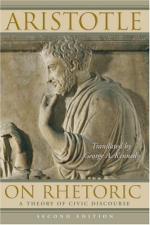
|
| Name: _________________________ | Period: ___________________ |
This test consists of 5 short answer questions, 10 short essay questions, and 1 (of 3) essay topics.
Short Answer Questions
1. Based on Aristotle's views, how should any good speech be appropriate?
2. In Aristotle's opinion, what did simple words convey?
3. In Book II, Chapter 26, how many common errors did Aristotle discuss?
4. What did Aristotle indicate was the result of using complex, foreign words?
5. In Aristotle's opinion, why should political rhetoric focus the most on sound argumentation?
Short Essay Questions
1. Based on the information in Book III, Chapter 10, which ideas could a metaphor help to deliver and why?
2. What clarification did Aristotle make about amplification, enthymemes, and the soundness of enthymemes at the end of the section?
3. How did Aristotle explain the different kinds of arguments used by the three types of rhetoric in Book II, Chapter 18?
4. Based on Aristotle's discussion at the beginning of Book II, Chapter 12, which things could influence a person's feelings?
5. How might the antithesis sayings emphasize a particular point?
6. Which example did Aristotle use to display the fallacious ways an enthymeme could be formed?
7. Which styles of political, forensic, and epideictic rhetoric were discussed at the end of Book III, Chapter 12?
8. How did Aristotle define a maxim?
9. As explained by Aristotle, what four common mistakes were made while writing prose?
10. What were the four ways that Aristotle listed about how objections could be raised?
Essay Topics
Write an essay for ONE of the following topics:
Essay Topic 1
Legal rhetoric was a main form of speech for courts and trials in Aristotle's time.
1) Describe the similarities and differences between the two types of law: the special and the general.
2) Explain Aristotle's definition of wrongdoing.
3) Analyze how both laws applied to wrongdoing and legal rhetoric.
Essay Topic 2
In proving a case or argument, a rhetorician should know how to object to opposing views.
1) Describe why objections were necessary in rhetoric.
2) Explain the four types of objections in rhetoric.
3) Analyze two examples for each type of objection in rhetoric.
Essay Topic 3
Aristotle's life and background had a key part in the success of his writings on rhetoric.
1) Describe the time period in which Aristotle lived, his background, and his intentions when writing the book.
2) Explain Aristotle's writing style and three examples of the techniques he used.
3) Analyze the effect that Aristotle's background and writing style had on his work in On Rhetoric: A Theory of Civic Discourse.
|
This section contains 849 words (approx. 3 pages at 300 words per page) |

|




